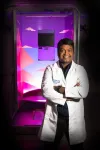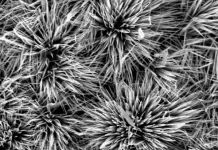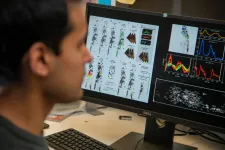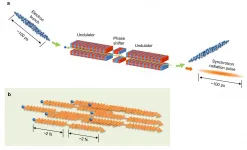Researchers identify barriers to use of surface electromyography in neurorehabilitation
Kessler Foundation team proposes comprehensive approach to integrating surface electromyography into clinical practice as path to improving rehabilitative care for individuals with spinal cord injury
2021-03-17
(Press-News.org) East Hanover, NJ. March 17, 2021. Kessler Foundation researchers have identified several practical and technical barriers to the widespread use of surface electromyography (sEMG) in clinical neurorehabilitation. Based on their holistic analysis of these factors, the researchers suggest a collaborative, interdisciplinary, and unified approach to enable rehabilitation professionals to routinely use sEMG. The article, "Use of Surface EMG in Clinical Rehabilitation of Individuals With SCI: Barriers and Future Considerations" (doi: 10.3389/fneur.2020.578559), was published December 18, 2020, in Frontiers in Neurology. It is available open access at https://www.ncbi.nlm.nih.gov/pmc/articles/PMC7780850/
The authors are Rakesh Pilkar, PhD, Kamyar Momeni, PhD, Arvind Ramanujam, Manikandan Ravi, Erica Garbarini, and Gail F. Forrest, PhD, affiliated with the Center for Mobility and Rehabilitation Engineering Research and the Tim and Caroline Reynolds Center for Spinal Stimulation at Kessler Foundation.
sEMG is a noninvasive technology that detects, records, and interprets the electrical activity of muscles. The quantifiable information on myoelectric output recorded by sEMG is extremely useful in assessing impairment and potentially determining patient-specific and effective interventions for individuals with spinal cord injury (SCI). However, while sEMG is commonly used in neurorehabilitation research, its integration into clinical practice has been limited, according to lead author Dr. Pilkar, senior research scientist at the Center for Mobility and Rehabilitation Engineering Research.
In their analysis, the research team determined several factors that prevent widespread use of sEMG in clinical practice. "One major obstacle is integrating the time-consuming aspects of sEMG into the already demanding schedule of physical therapists, occupational therapists, and other clinicians," explained Dr. Pilkar. "Also, clinicians are often unfamiliar with technical aspects of sEMG data processing and may not have been exposed to or trained in certain aspects of this technology," he added.
The research team also identified technical challenges such as transferring the frequent research updates to the sEMG systems used in a clinical setting; lack of user-friendly interfaces; and the need for a standardized, multidisciplinary approach to the handling and interpretation of data. An additional consideration, specific to research in SCI, is that reading and interpreting EMGs for this population requires an additional skillset, as the physiological and structural state of the spinal cord affect how data are interpreted.
To overcome these obstacles, Kessler researchers propose a series of actions to facilitate the use of sEMG by rehabilitation professions. First, including hands-on sEMG experience in educational and professional training programs, and exposing trainees to non-clinical experts in complementary fields such as engineers, technicians, and data scientists. Second, developing simpler, more user-friendly technology interfaces, as well as offering open-access user tutorials to make it easier for clinicians to integrate and use sEMG. Third, codifying a means to regularly transfer research-based knowledge about sEMG and its relevance to SCI rehabilitation from researchers to clinicians will empower rehabilitation professionals to use sEMG with more confidence.
"Addressing these barriers will improve our ability to objectively assess neuromuscular outcomes," Dr. Pilkar predicted, "which is fundamental to developing interventions that improve motor function and mobility in individuals with deficits caused by SCI."
INFORMATION:
Funding sources: New Jersey Commission on Spinal Cord Research (CSCR20ERG013, 314 CSCR14ERG007) and Kessler Foundation
About Kessler Foundation
Kessler Foundation, a major nonprofit organization in the field of disability, is a global leader in rehabilitation research that seeks to improve cognition, mobility and long-term outcomes, including employment, for people with neurological disabilities caused by diseases and injuries of the brain and spinal cord. Kessler Foundation leads the nation in funding innovative programs that expand opportunities for employment for people with disabilities. For more information, visit KesslerFoundation.org.
For more information, or to interview an expert, contact: Carolann Murphy, 973.324.8382, CMurphy@KesslerFoundation.org
[Attachments] See images for this press release:

ELSE PRESS RELEASES FROM THIS DATE:
2021-03-17
Autoimmune diseases are typically caused when the immune system, whose purpose is to deal with foreign threats to the body, incorrectly recognizes the body's own proteins and cells as threats and activates immune cells to attack them. In the case of rheumatoid arthritis, a well-known autoimmune disease, immune cells erroneously attack the body's own joint components and proteins, causing painful inflammation and even the destruction of bone! Scientists from Japan have now taken a massive step toward understanding and, potentially, treating rheumatoid arthritis better, with their discovery in a brand-new study. Read on to understand how!
The development of autoimmune diseases is an incredibly complex process, involving several key players ...
2021-03-17
A sustainable, powerful micro-supercapacitor may be on the horizon, thanks to an international collaboration of researchers from Penn State and the University of Electronic Science and Technology of China. Until now, the high-capacity, fast-charging energy storage devices have been limited by the composition of their electrodes -- the connections responsible for managing the flow of electrons during charging and dispensing energy. Now, researchers have developed a better material to improve connectivity while maintaining recyclability and low cost.
They published their results on Feb. 8 in the Journal of Materials Chemistry A.
"The supercapacitor is a very powerful, energy-dense device with a fast-charging rate, in contrast to the typical battery ...
2021-03-17
An international collaboration between Great Ormond Street Hospital, the UCL GOS Institute for Child Health and Harvard Medical School has shown that the beneficial effects of gene therapy can be seen decades after the transplanted blood stem cells has been cleared by the body.
The research team monitored five patients who were successfully cured of SCID-X1 using gene therapy at GOSH. For 3-18 years patients' blood was regularly analysed to detect which cell types and biomarker chemicals were present in their blood. The results showed that even though the stem cells transplanted as part of gene therapy had been cleared by the patients, the all-important corrected immune cells, called T-cells, were still forming.
Gene therapy works by first removing ...
2021-03-17
In researching the causes and potential treatments for degenerative conditions such as Alzheimer's or Parkinson's disease, neuroscientists frequently struggle to accurately identify cells needed to understand brain activity that gives rise to behavior changes such as declining memory or impaired balance and tremors.
A multidisciplinary team of Georgia Institute of Technology neuroscience researchers, borrowing from existing tools such as graphical models, have uncovered a better way to identify cells and understand the mechanisms of the diseases, potentially leading to better understanding, diagnosis, and treatment.
Their research findings were reported Feb. 24 in the journal eLife. The research was supported by the National Institutes of ...
2021-03-17
Hydrogen is a pollution-free energy source when it's extracted from water using sunlight instead of fossil fuels. But current strategies for "splitting" or breaking apart water molecules with catalysts and light require the introduction of chemical additives to expedite the process. Now, researchers reporting in ACS ES&T Engineering have developed a catalyst that destroys medications and other compounds already present in wastewater to generate hydrogen fuel, getting rid of a contaminant while producing something useful.
Harnessing the sun's energy to split water to make hydrogen fuel is a promising renewable resource, but it is a slow process even when catalysts are used to speed it along. In some cases, alcohols or sugars are added to boost the rate of hydrogen production, ...
2021-03-17
NEW YORK (March 17, 2021) -- High speed air dryers not only leave more contamination on poorly washed hands compared to paper towels, but during hand drying, they can also spread germs onto clothing, ultimately transferring more bacteria to other surfaces, according to a study published today in Infection Control & Hospital Epidemiology, the journal of the Society for Healthcare Epidemiology of America.
Past research has shown recommended handwashing practices for healthcare workers are often not followed with average adherence of 40%. To better understand the impact of hand drying in hand hygiene, researchers conducted an experiment to learn the role of different hand drying methods in spreading germs from poorly washed hands beyond the restroom.
For ...
2021-03-17
Scientists in Japan have observed, and interfered with, the ultrafast motion of electron movement inside of a Xenon atom using the coherent pairs of short light waves in synchrotron radiation. Xenon, consisting of a nucleus surrounded by five nested shells containing a total of 54 electrons, is used in flash lamps, and it burns bright and fast. The luminescent electrons move there on a time scale of one billionth of a second. The fast electron movement is however six orders of magnitude slower than that the scientists observed. Using the synchrotron facility at Institute for Molecular Science, they tracked the electron movement in relaxation to shed energy by dropping from an outer shell to an inner shell. The process happens at a timescale of femtoseconds, ...
2021-03-17
Researchers at Lund University in Sweden have designed a new bioink which allows small human-sized airways to be 3D-bioprinted with the help of patient cells for the first time. The 3D-printed constructs are biocompatible and support new blood vessel growth into the transplanted material. This is an important first step towards 3D-printing organs. The new study has been published in Advanced Materials.
Chronic lung diseases are the third leading cause of death worldwide with an EU cost of more than €380 billion annually. For many chronic diseases ...
2021-03-17
The promotion of psychosocial health among individuals, groups, and society is an increasingly important subject in the field of public health. Psychosocial health is a complex interaction between the psyche of an individual and the social environment in which that individual lives. Promoting psychosocial health is often challenging and complex for health care professionals. Therefore, an important question of public health significance is: "how can we address and improve the psychosocial health of individuals, groups, as well as society in general?"
An interdisciplinary team of specialists ...
2021-03-17
The use of artificial light at night around the world has increased enormously in recent years, causing adverse effects on the survival and reproduction of nocturnal organisms. Artificial light at night interferes with vital ecological processes such as the nighttime pollination of plants by nocturnal insects, which could have consequences for agricultural crop yields and reproduction of wild plants.
Scientists from the University of Zurich and Agroscope have now demonstrated for the first time that artificial light at night also adversely affects insects' pollination behavior during the daytime. In an experiment, they used commercial ...
LAST 30 PRESS RELEASES:
[Press-News.org] Researchers identify barriers to use of surface electromyography in neurorehabilitation
Kessler Foundation team proposes comprehensive approach to integrating surface electromyography into clinical practice as path to improving rehabilitative care for individuals with spinal cord injury




